Preparing blackberries for winter: pruning in the fall and shelter
Despite the outward belligerence, which is expressed by hundreds of thorns covering the stems of the plant (however, cultivars are usually thornless), blackberries require careful care in each period of their growing season: both after winter - in spring, and during fruiting (in summer) and after its end and harvest (in the fall), of course, if you want to get the most from your blackberry bushes every year, especially if you grow blackberries in conditions that are not very favorable for them.
Next, we will analyze in detail what needs to be done with the bush in the fall (in short, then - feed, cut and cover) in order to properly prepare the blackberry for winter.
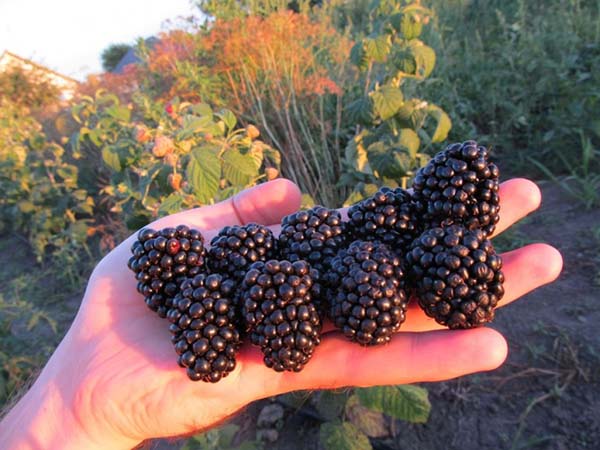
Content
What to do with blackberries in the fall after fruiting: the main measures for preparing a shrub for winter
In order for blackberries to endure the winter without consequences, you should not rely solely on covering material. As you know, only a well-groomed and healthy plant can endure long cold weather, therefore, the following are also among the measures for preparing blackberries for winter:
- trimming;
- top dressing;
- and direct shelter for the winter.
Pruning blackberries in autumn
Before you start pruning a blackberry (and any plant), you should figure out which shoots it bears fruit and what its life cycle is. So:
- Blackberry is a shrub with a two-year development cycle that bears fruit on last year's shoots. In other words, after fruiting, you need to get rid of them, because they will no longer bear fruit and are not suitable for reproduction.
Advice! You can propagate by rooting the tops of young shoots in August.
In general, the site has a separate article about how to propagate blackberries, where all possible methods are described.
- Accordingly, young shoots of the current year will bear fruit only the next, i.e. they must be preserved without fail, namely, sheltered for the winter, so that they winter well and give a normal harvest in the next season.
When to prune blackberries after fruiting (autumn): optimal pruning times
Blackberry pruning should be done immediately after it finishes fruiting, in other words, as soon as you collect all the berries (harvest), you can immediately begin to remove the sprouted shoots.
It is worth understanding! Most likely, you will say that the autumn pruning of blackberries is not at all autumnal, but summer. However, pruning after fruiting and / or in August, it is customary to call it "autumn", not "summer".
Thus, the approximate timing of the autumn pruning of blackberries after fruiting is August-September (October - for late varieties), in the South - earlier, and in the Middle lane (Moscow region) - later.
Why you should not postpone the pruning procedure until late autumn?
Everything is obvious: this is done so that the bush does not waste extra energy on feeding old unnecessary shoots, but sends them to a young growth so that it fully develops, matures and is well prepared for winter.
Video: pruning blackberries in the fall
Pruning rules or what blackberry shoots can and cannot be cut in autumn
What branches of blackberries do you need cut off completely for autumn pruning:
Remove completely = cut at the root without leaving any stumps.
- all last year's (2-year-old) shoots that bear fruit;
It is very easy to distinguish them from fresh ones (this year), because dried peduncles, berries remain on them, and their leaves turn yellow and begin to fall off.
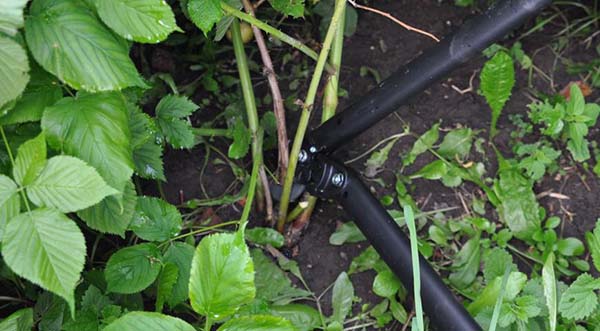
What branches cannot be cut in autumn pruning:
- young shoots of the current year;
- side shoots (stepchildren) on these young shoots.
Do not leave one main barrel as it is. blackberries bear fruit well on stepsons.
Which shoots should correct length:
- if over the summer the young branches of the current year have grown very much and have clearly become not along the length of your trellis, then they should be shortened by cutting to the required length (as a rule, they are left up to 1.8-2 meters).
Interesting! Sometimes you can find a direct recommendation about pinching the tops of young shoots, which will stimulate their better branching (formation of lateral shoots).
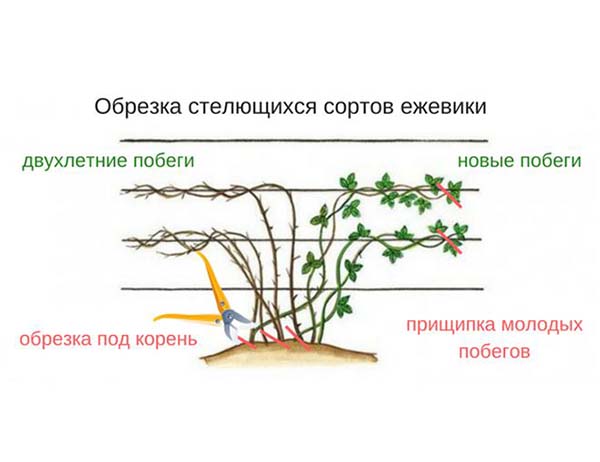
Important! If the volume and space of the trellis allows you to accommodate the entire growth, and the bushes are provided with a large nutritional area - they are planted at an optimal distance from each other (on average 1-2 meters) - then you can not cut them, because in this case you will simply deprive yourself of a part possible harvest.
However, if you are not ready to take good care of (regularly water, feed) such long bushes, then keep in mind that without good nutrition they simply cannot bear fruit normally.
Video: pruning blackberries after fruiting in the fall
Another important and frequently asked question regarding blackberry pruning: “Is it necessary to normalize the number of shoots of the current year?»
- It is believed that the root system of a healthy medium-sized bush may well contain 5-8 productive shoots. However, as a rule, this is exactly how many of them are formed, in other words, you will have nothing to normalize.
Moreover, it is worth knowing the higher the yield, the less formed replacement shoots.
Loosening after pruning
After the autumn pruning of blackberries, some advise to loosen the soil under the bushes a little, on which only young shoots of the current year are left (Did you forget that only those that bear fruit are pruned?).
Worth knowing! It is believed that it is not recommended to loosen blackberries, because if you loosen close to the roots, then next year a lot of root growth will form.
However, for example, blackberries of the Thornfree variety do not give such a strong growth when loosening, as Black Satin or Karaka Black ...
Autumn feeding of blackberries
To make the plant easier to survive the winter, as a rule, it is recommended to perform autumn feeding with phosphorus-potassium fertilizers (without nitrogen or with its minimum amount).
Thus, when choosing what to feed the blackberries in the fall, you can choose the following fertilizers:
- superphosphate + potassium sulfate (potassium sulfate);
- potassium monophosphate;

- any ready-made specialized "autumn" fertilizer.

Shelter blackberries for the winter
Since this berry shrub does not have high frost resistance and bears fruit only on last year's shoots, it is imperative to cover the blackberry before winter, otherwise there is a risk of freezing of this plant. However, of course, this does not apply to warm southern regions (the same Kuban, Krasnodar Territory).
Important! Even cold-resistant blackberry varieties must be covered for the winter. Such plants are able to withstand frost down to -20 ..- 25 degrees, less frost-resistant blackberry varieties - up to -15 ..- 17 degrees.
When to cover the blackberry
As a rule, it is recommended to start insulating blackberries when the night temperature drops to -5 degrees, and during the day it will be below or around 0, i.e. when stable frosts begin.
But it is better to prepare the branches for shelter, namely, to collect them in bunches (twine with twine) and bend (translate to a horizontal position) in advance, at least 7-14 days before the direct shelter, i.e. to a strong cold snap, since during frost the branches become brittle.
Worth knowing! It is believed that blackberries usually do not die and overwinter easily with green leaves. In other words, you don’t have to wait until frost starts or leaves turn yellow and fall off (this simply will not happen, you will need to do it yourself). On the other hand, there is still a chance of damping out, so it is not worth covering the blackberries for the winter too early, moreover, some even recommend cutting the green leaves by hand.
How to cover blackberries
It is better to use white nonwovens (agrofibre) as a covering material for blackberries: the same lutrasil, spunbond.
However, it will be even better if you create an air gap (between the blackberries, the ground and the covering material), rather than just wrap the shoots with non-woven fabric. So, as a mulching material, you can use spruce branches (spruce branches), corn and sunflower tops, hay, straw, foliage of infertile (ornamental) trees (someone, in general, puts bottles).
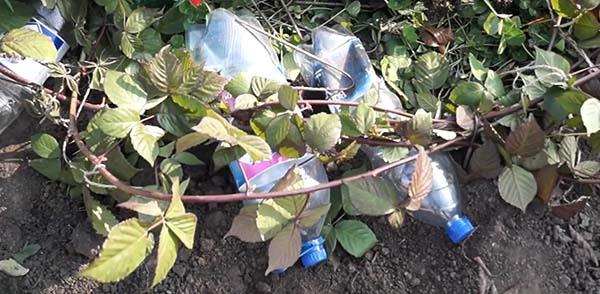
Do I need to remove the leaves before sheltering for the winter
Most are of the opinion that blackberries should hibernate with a green leaf.
However, with a too large leaf apparatus, it can rot, and then you can lose fruitful shoots. Therefore, it is better to carefully cut off all the leaves in advance, slightly stepping back from the trunk of the blackberry.
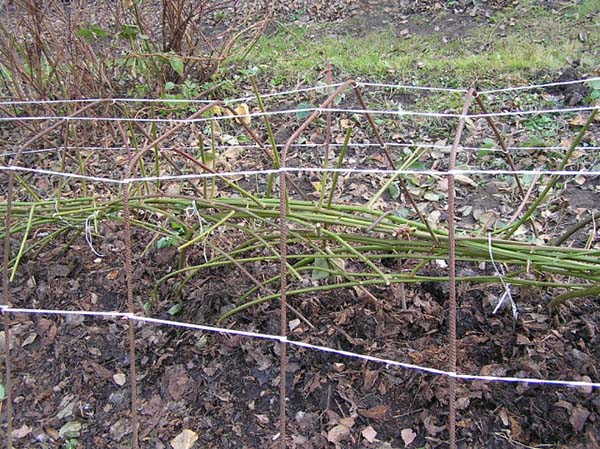
Worth knowing! It makes no sense to preserve blackberry leaves, since in the spring they will still not work for the bush, but rather become freeloaders (they will very little participate in photosynthesis, but they will pull food).
Video: preparing blackberries for shelter
How to properly cover blackberries for the winter
After pruning and cleaning the site, you can start sheltering the shrub for the winter.
The process of preparing shrub stems and direct shelter is as follows:
- The near-trunk circle is mulched, creating an air gap.
- Then the stems of the climbing shrub are carefully collected into a free bunch, including the side stems (it is most difficult to pull them to the central lash), tying with a special tool called "tapener ", either tying it with twine, or wrapping it in tights, and carefully bend to the ground.
In other words, you need to "horizontalize" the shoots that previously grew more vertically.
Advice! In general, from the very beginning, you need to try to lead the young growing shoots of blackberries horizontally above the ground, then it will be much easier for you when they are sheltered for the winter.
- Further collected lashes fixed with hooks (pinned with staples to the ground).
Interesting! The process is very similar with shelter of climbing roses, grapes, in short, long-leaved plants.
- From above cover (wrap branches) with non-woven material (agrofibre).
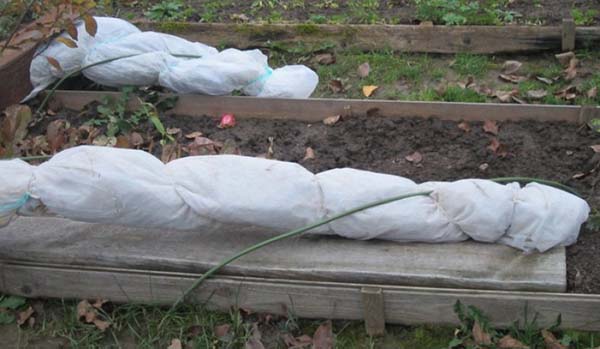
For another way to hide blackberries for the winter, see the following video:
However! In the comments, one of the gardeners made the following important remark: “Leave an air gap between the agrofibre and the plant, otherwise it will not protect against frost. I was convinced of this in the cold May 2017, in freezing temperatures of -6 degrees. Where it touched, the blossoming shoots and the planted seedlings were frozen over, and where there was a gap of 5 cm or more, they remained intact. "
Video: the easiest way to hide a blackberry bush for the winter
Thus, after a thorough study of the theory of autumn care for blackberries, you can safely arm yourself with a garden tool and consolidate the acquired knowledge in practice, which in the next season will certainly be fully rewarded with a generous harvest of large and juicy blackberries.

